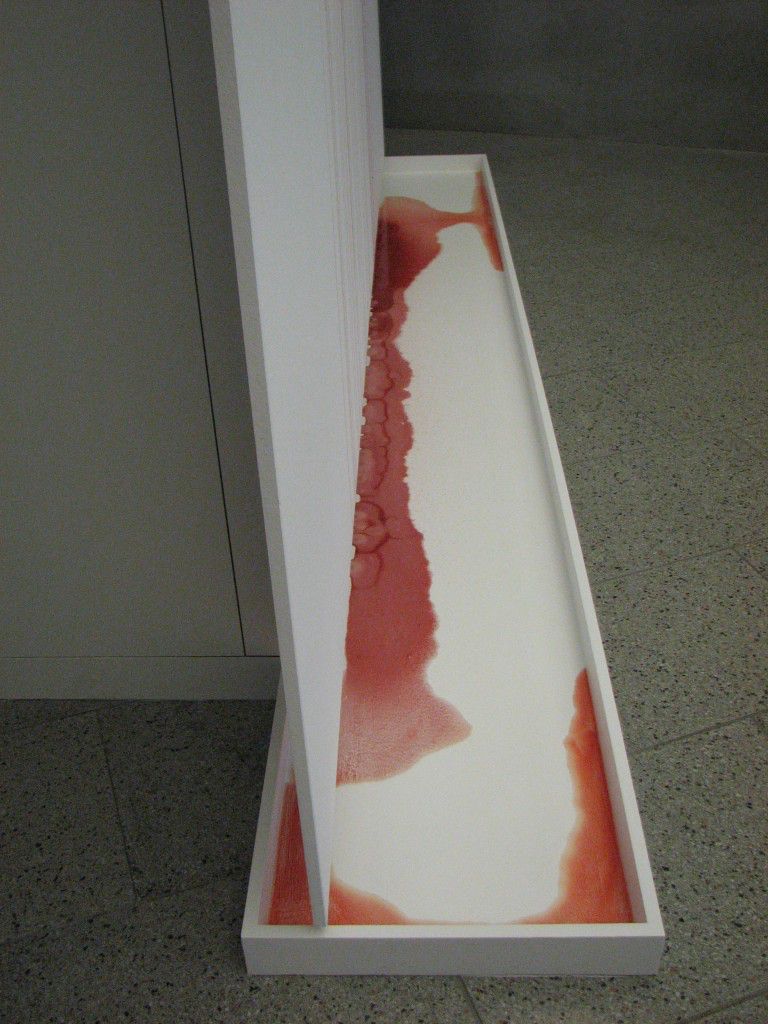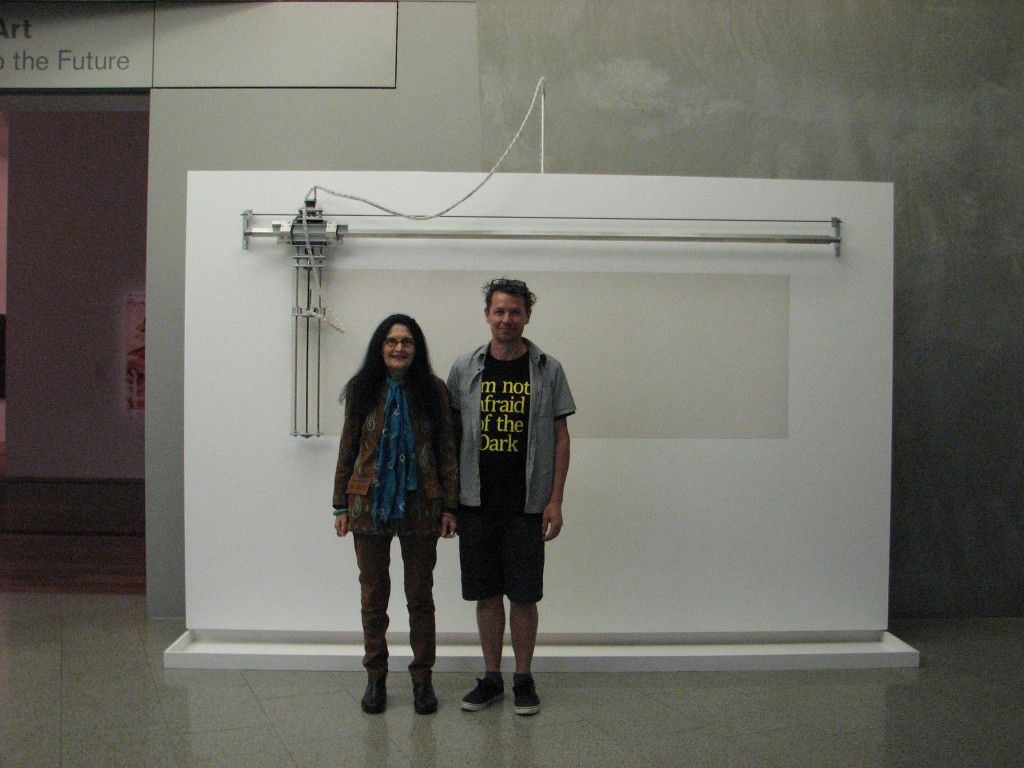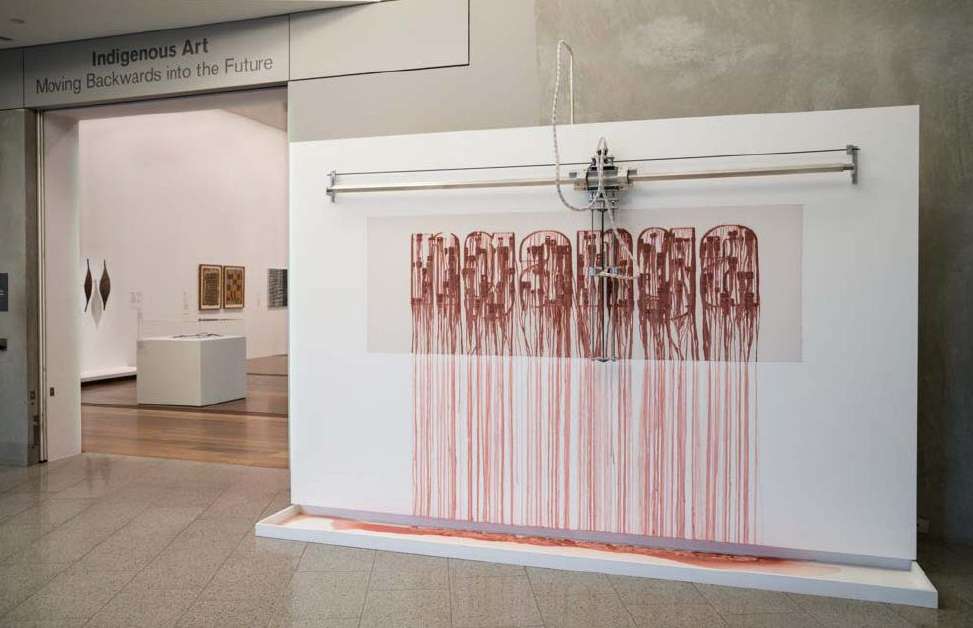
An interview with artist Robert Andrew on the creation and future care of his work Moving out of Muteness (2013), currently on display at the NGVA as part of the Indigenous Art: Moving Backwards into the future exhibition.
DW: Can you describe the artistic intent and key aesthetic or functionality of the work?
RA: Somewhat like in an archaeological dig, the desire to unearth, to reveal and to understand what ‘lies beneath’ is the impetus behind my art practice. The central theme and focus of ‘digging up’ and uncovering Australian, family and personal Indigenous histories through the scraping back of dominating histories reveals the denied, the forgotten and the hidden. This leads to me to being an observer and a participant in an evolving hybridity of Indigenous and non-Indigenous emotional and conceptual spaces and perspectives.
This work: Moving Out of Muteness is located within the socio-political contexts of Australia dating from the British invasion in 1788 to the present of 2013. It emerges from Western Australian history, with specific attention on my own family’s histories and experiences between 1900 and 2013.
I can refer to this time period because information about this period is still accessible through oral histories of family and friends and through existing documents collected from a variety of governmental departments.
I have made the work from the position of what I am calling ‘un-forgetting’ – by which I mean recalling and re-presenting something deliberately forgotten, something intentionally put away. Un-forgetting provides a way in to re-evaluate my family’s and my own personal identity.
The three-dimensional, performative installation Moving Out of Muteness is an erasure and re-inscription machine because it paradoxically creates images and text through erasure rather than through a usual process of image creation of material build up.
DW: Your work with ochres and natural oxides in a number of your works can you elaborate on the origin and significance of this material to you and this work in particular?
RA: My earliest memories of our family road trips up north from Perth to the Kimberly were of the red earth. I always saw the red earth as signifying my mothers original home, her birth place some of our family’s country.
I am always excited to see the pindan or red soil. So to use these oxides and ochres, some of which originate from the Broome region, gives a personal and family link to the conceptual issues of Indigenous identities and historical erasure within the work.
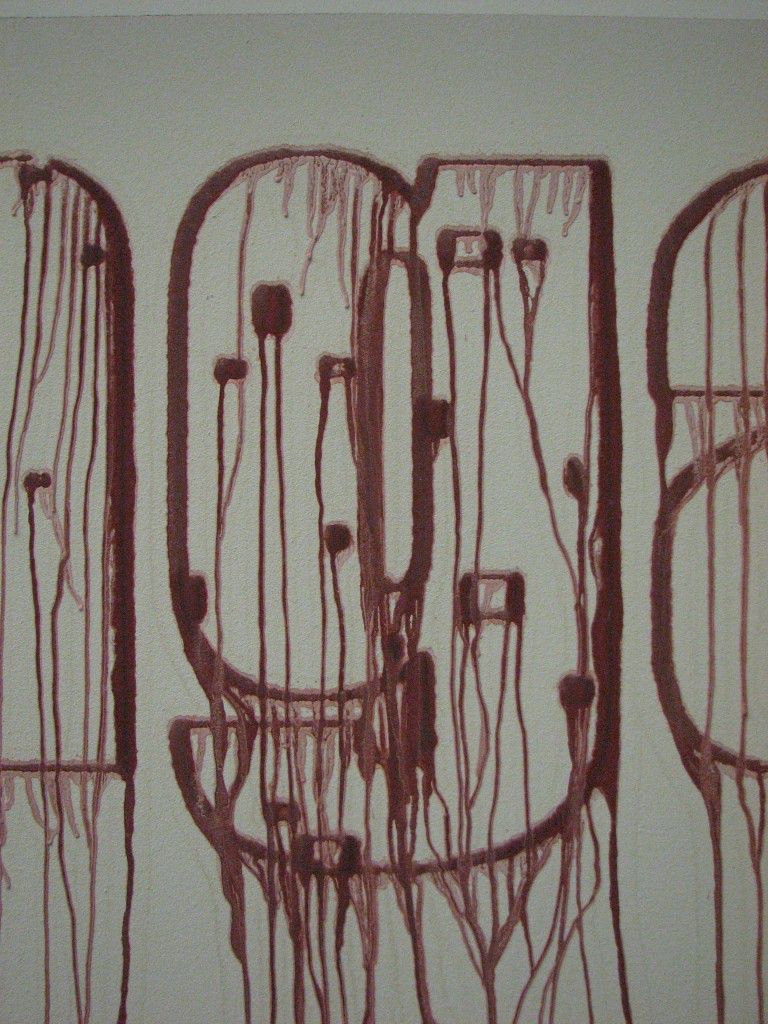
DW: Your works utilise many different media including digital technology and programming, are you conscious of a need to update your skills, keep abreast of developing tech? If so how do you approach this? local networks, international, colleagues, online forums, user groups…
RA: There is a great open-source community online whose participants are constantly developing, updating and improving off-the-shelf technology. When I have a project that requires certain skills, I usually find the skill set or components of the necessary skills in these open-source online forums.
For the work Moving out of Muteness I had to research, primarily online, how to use stepper motors, their associated drivers and the code necessary to drive them. Originally I had every move of the machine manually programmed in, step-by-step. Eventually through the help given on various 3-D printing forums, I was able to simplify the process. I was able to input the text or images into a few programs and then translate this into the G-code that now runs the erasure mechanism.
While there is no step-by-step guide to do what I would like to achieve, there is enough information in these forums to piece together your own ‘how to’ guide. It just takes time and patience.
DW: How/do you filter, choose starting points with new media?
RA: I am slowly gaining the confidence to know that when I begin to play with new media that this process will result in positive outcomes – even if I don’t have an immediate use for what the research has uncovered. For example the original concept for the Moving Out of Muteness project was to use a black board with white chalk rubbed on the surface, then to use water to wash off sections to created the final text.
Starting off with a squirt-bottle and a matt-black painted board, this led to the need to automate the water process. However the experiments with the chalk gave some interesting results as I built up and layer upon layer and then erased sections of the surface. From this I developed a technique to apply multiple thin layers of oxides and ochre onto a blackboard-like substrate.
There is no predefined method to my approach in my practice-lead research. Sometimes it’s the serendipitous moments that result in the most interesting outcomes and discoveries.
I remain open to the unexpected, the happenchance and the unimagined.

DW: How do you develop a kinetic work – do you manufacture to concept/desired end result, or does the concept evolve from the possibilities of the available tech and your capability to subvert modify or redirect the technology?
RA: I think that I have retained, in some way, the delights of the inquiring child who doesn’t necessarily think in terms of limitations, but rather thinks in terms of imagining, dreaming and scheming. This is something that I have carried on from my early experimentations with technology as a young person.
DW: Are you conscious of the design process and desired/evolving aesthetic of the mechanism or is this secondary to the end result?
RA: I have a deep interest in the visual shaping of the world so it always underpins my approach to materials and mechanisms. In Moving Out of Muteness, the process was that once I had worked out the concept of a palimpsest machine that erodes and rewrites on a built-up surface I then worked on the mechanics and the aesthetics hand-in-hand.
The function of the machine locks in certain aspects of the design. That is: physical form is partially informed by the process that the mechanics has to perform. Once the components and materials are in their most basic form so that they function as I intend, the look and feel of the machine is then tied into the conceptual framework.
In moving Out of Muteness I wanted the machine element to have a specific machine aesthetic. However I wanted to locate this aesthetic away from the known formats of a printing devices from were it was conceived.
I was really fascinated to see the drawing machine artwork of Angela Bulloch in the NGV early last year that has a similar scale and purpose. However it has a very different aesthetic.
DW: Do you work through physical iterations of the mechanism and how do you determine an endpoint?
RA: I do a lot of initial hands on with materials, components and electronics to achieve the desired mechanical action for the final work. With this understanding I rough sketch and then take these images into a 3-D CAD program to finalise the design. In my previous line of work I built virtual 3-D environments, engineering models and buildings. I animated and illustrated these concepts to give clients realistic views of their un-built buildings and products.
This way of working is also really valuable for my own work to get a good understanding of the ‘look’ and the scale of the work in the space that I intend to place it. This process also provides a reasonably accurate drawing to start the manufacture process.
DW: Are there aspects or components of the assembly that are not significant to ‘the artwork’?
RA: I attempt to have consideration of all the components and materials and how they are read as part and of the whole work. Most elements have a significant connection to the theme or concept the work engages with. Other elements that may have a more utilitarian use within the work have been chosen for the way they fit and add to the overall work.
One aspect in residue works is the need for a suitable residue containment tray or mechanism to receive the residues.
At an installation of the work in Cairns, while I knew there would be residues forming at the base of the work, I was surprise to see how much the work created a 3-D environment that was built up from the erosion of the wall surface into the tray over the time. This reformation hopefully continues the conversation with the work and adds to and strengths the original concepts.
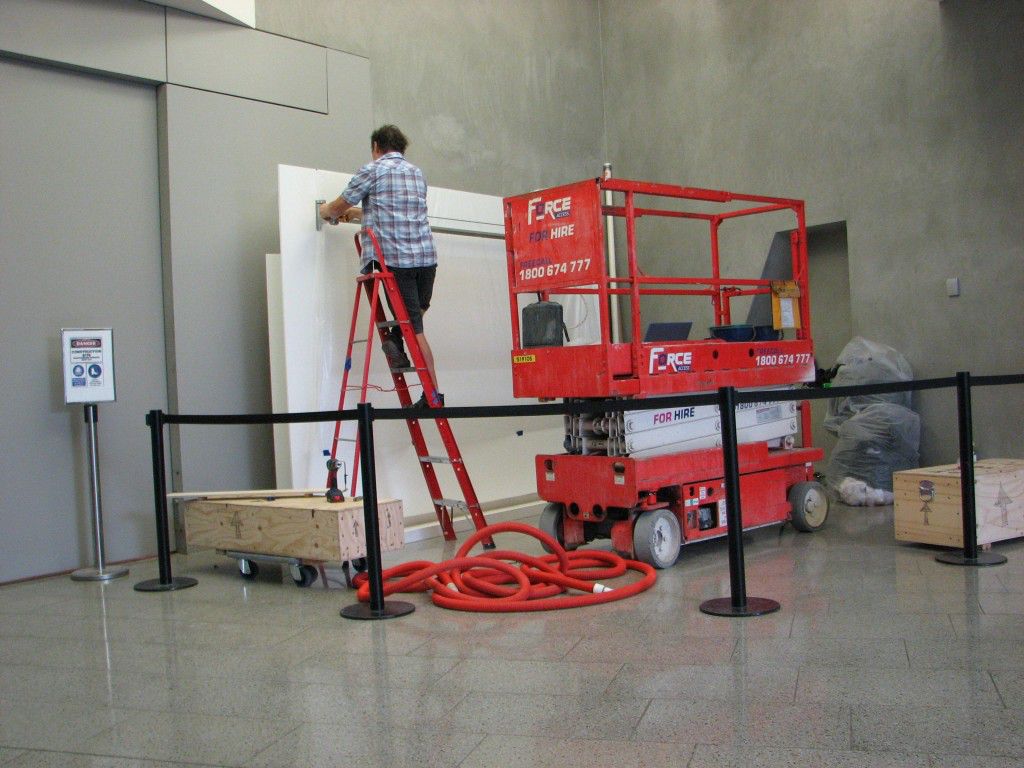
DW: Are there any aspects of the design or function you would change now that you have installed it again?
RA: I am always thinking of better ways to apply the ochres and chalk layers.
DW: How important is the fact that you manufacture the tech yourself? Write the code … can this be modified by others?
RA: Part of my studio research methodology is playing and learning about different technologies. These technologies don’t always have to be high-tech or cutting edge. I find sometimes that an artwork concept comes from this play and sometime the play is informed by a concept. Within this area of exploration I make a lot of discoveries on how things work together or don’t. To do this exploration of technologies and to put them together myself gives the opportunity to see other applications that I may have not see by having major element manufactured by others. This process also gives me better understandings of how to fix unforeseen problems!
DW: You provided the NGV with detailed installation instructions have you considered future repairs, hardware and software migration?
RA: I have built a second machine to continue to explore the erosion process on the ochre and chalk substrates. The new machine retains a lot of its origins from the work in the NGV. Having worked on both machines, I will keep evolving the mechanism to aid in maintenance and possible repairs.
I am already working on a quick-release system for the injector maintenance. As the electronics and stepper motors are all off the shelf items these can be easily sourced and, in time if unavailable, could be easily substituted with available technologies.
The initial software and work were originally run for two hours and though the potential was there, the work was never programmed for more than the day. When the machine was installed at the Cairns Regional gallery in 2014 for the Cairns Indigenous Art Fair, the programming was updated to run over the month.
With the installation for the NGV exhibition: Moving Backwards into the Future, there was a need to update and reconfigure the programming to run for more than 100 days. This meant altering the way the image built up over time and the re-design of gaps and spaces within the day’s erasure. Now the work will complete around 40 erasures (squares) over the day. The actions will be about 8 minutes apart, doing a different sequence every day for the duration of the exhibition. If there is ever a need to respond to a current issue or theme, it maybe possible that the erasure process could be changed to become a new art work.
DW: How do you see the work aging, particularly in relation to visible hardware? (for example, should the work clearly reflect the era in which it was created or can the work continue to evolve with upgrades and changes in technology)
RA: I feel that the hardware should remain reasonable consistent in appearance to how it is in its current state. There may be a few alterations to it on a component level but I see these as having a relatively minor impact on the visual aesthetic and the read of the machine as it is in its present state.
DW: A previous work Mimi (2013) has a liquefied ochre? running over the floor of the gallery space – this work uses a floor tray to collect the residue. Have you considered modifications to works for commercial gallery applications / the potential constraints, compromises ie timing alteration for NGV display. Does this influence the design of future works?
RA: I don’t think I’ll be able to recreate the original installation of the Mimi work in a commercial gallery were there isn’t a residue containment area (ie a tray). However, I think that there is perhaps scope for the area of residue containment to become a navigable space for the viewer.
This original work was mounted and ochres and chalk applied directly to the wall. I would love the opportunity to be able to run the work this way again. There is also something very appealing about the residues “bleeding across the floor”!
Working with water and the raw ochres and chalk will always be challenging for a commercial gallery. I’d like to be able to push the limits of what is possible if the opportunities arise.
‘Compromises’ are always something an artist using kinetic works needs to be mindful of, and for me, that means that I need to alter the way it works so that it has a minimal risk profile to the viewer and the gallery space and equipment. The mechanics of the work has evolved from the first iteration to fit comfortably within these parameters without compromising the intent of the work.
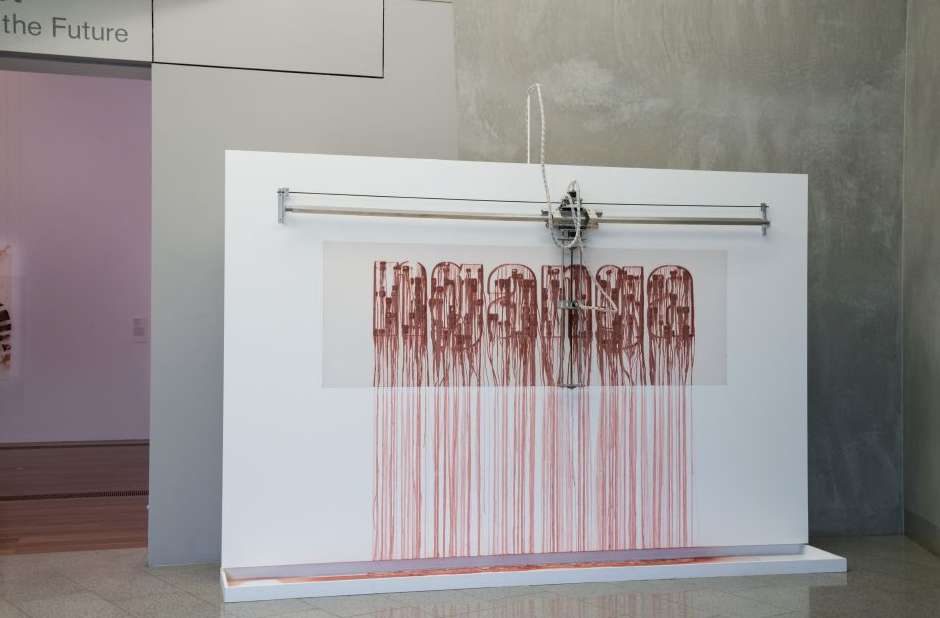
DW: How/does teaching & the university environment influence your work ? – interaction with students, proximity to tech based R& D, facilities & equipment, collaboration with other artists makers / manufacturers…..
RA: While I am currently undertaking Doctorate studies at Griffith University and working in studios with Visual Arts students where there is a cross-fertilization of ideas with staff and students, my technical research is largely conceived and constructed in my studio.
See Moving out of Muteness at the NGVA as part of the Indigenous Art: Moving Backwards into the future exhibition.
